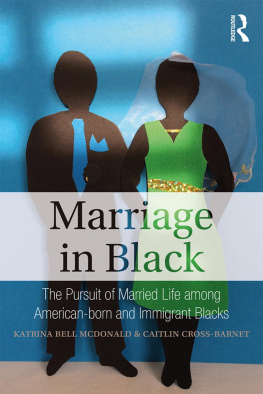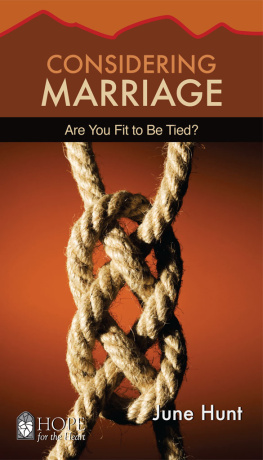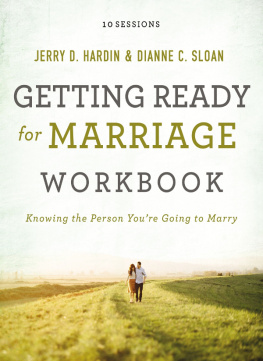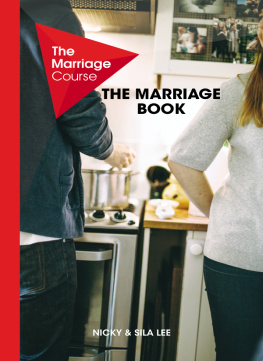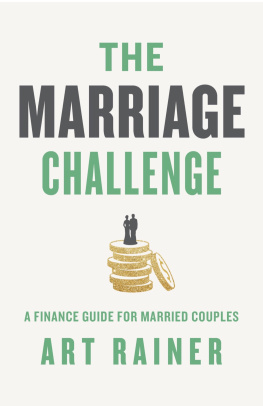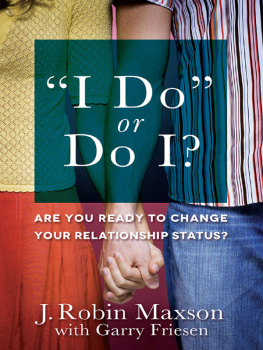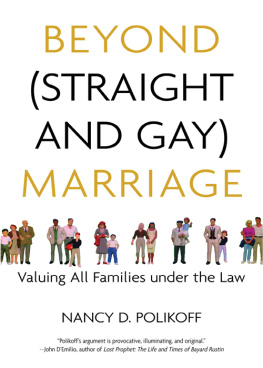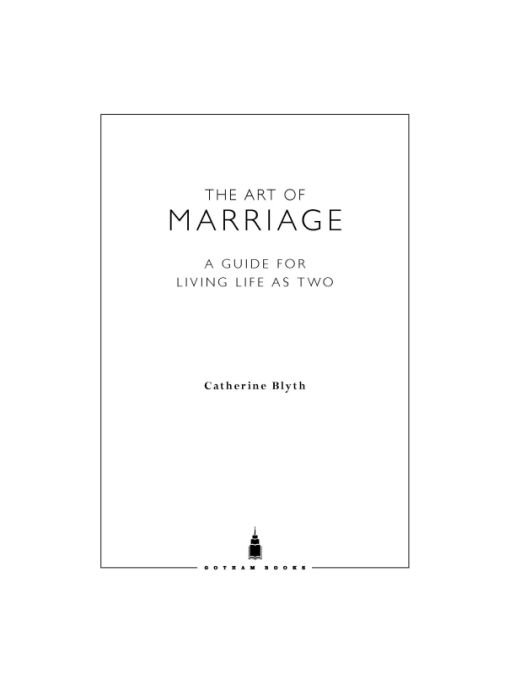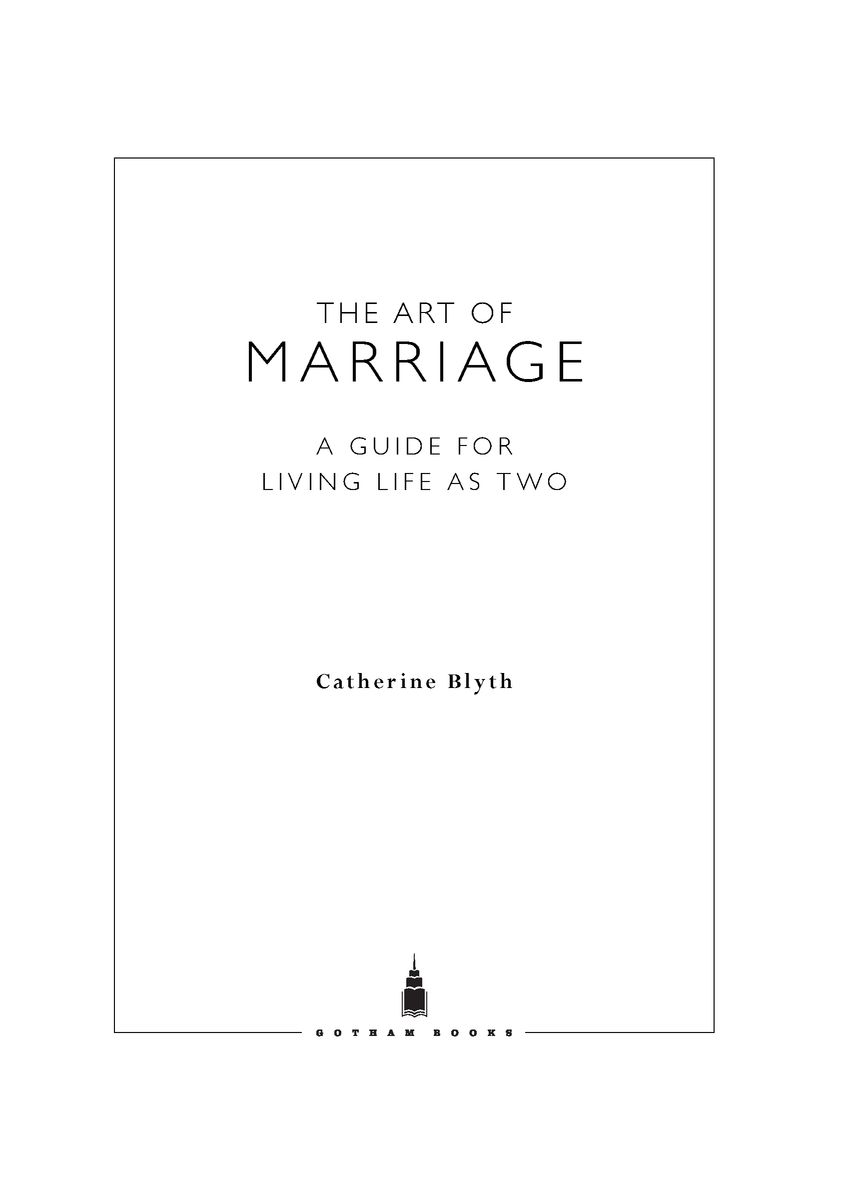Table of Contents
Also by Catherine Blyth
THE ART OF CONVERSATION
For Sebastian
Introduction
MARRY? WHY WOULD YOU WANT TO DO THAT?
Heor sheasks, Will you marry me? In the past, your range of acceptable replies was limited to Yes, No, When? and Ask me again, later. In the twenty-first century, this extraordinary question begs another: What for?
But as you walk down the aisle, arm in arm with your new spouse, your head is more likely to be filled with gauzy notions of everlasting love than doubts as to why you have voluntarily subsumed your identities in the impersonal clichs of bride and groom. The dreams embodied in these timeless, hopeful figures are taken as read. Still, if happiness writes white, the precise instructions for how a couple will reach their chosen destination, their happily ever after, are also elusive. Marriage is a very beautiful dream, but the practical task of merging two lives into one is not dwelt on in its mythology.
Not everyone is optimistic about marriage. On Christmas Day in 1685 the naval administrator Samuel Pepys noted in his diary, To church in the morning, and there saw a wedding in the church, which I have not seen many a day; and the young people so merry one with another, and it was strange to see what delight we married people have to see these poor fools decoyed into our condition, every man and wife gazing and smiling at them. Some find such spectacles intolerable. Mrs. Willis, who worked for my grandmother, declined an invitation to my parents wedding: I never go to weddings. Poor young things, all their troubles just beginning!
So hard was it to drag grooms to the altar in eighth-century B.C. Sparta that the ruler Lycurgus passed a law ordering that bachelors who were slow to marry should be excluded from summer games and shows, and in winter, be forced to patrol the forum, nude, uttering curses on their own heads that theirs was a just penalty for neglecting their civic duty. No amount of pressure from her own or other governments could persuade Elizabeth I of matrimonys merits. She told her French ambassador, When I think of marriage, it is as though my heart were being dragged out of my vitals. As her father, Henry VIII, severed ties with her mother, Anne Boleyn, by dividing Annes body from her head, Elizabeths misgivings are understandable. Yet the suspicion that a wedding marks not the start but the end of a charmed period has always haunted marriage, like an unwelcome guest, lurking outside the chapel.
After all, call your wedding day the happiest of your life, and what are you really saying?
That it is all downhill from here.
Marriage is an heirloom. The first recorded exchange of wedding rings took place in ancient Egypt in 2790 B.C., but the invention of marriage must predate this occasion by many moons. It exists to yoke men and women together, to draw lines around groups of people and call them families, ensuring the production of legitimate children and the peaceful inheritance of property and other social privileges. Without marriage, each kings death would have precipitated a war of succession. Each union forged a link in a chain of being that kept humanity at peace, allowing each generation to transmit its values to the next and society to reproduce itself more or less smoothly. Its success at this task has been such that while pyramids are ancient history, marriage is still with us. Whether it should be is another matter.
Until recently marriage was a rite of passage, the next thing to do in life, after learning how to shave or wear lipstick and to make your living. A spoiled playgirl heaves a sigh in Hitchcocks
The Lady Vanishes (1938):
Ive no regrets. Ive been everywhere, and done everything. Ive eaten caviar at Cannes, sausage rolls at the dogs. Ive played baccarat at Biarritz and darts with the rural dean. What is there left for me but marriage?
But do we still need to ink the ties of blood and affection in the legal contract of marriage? Today DNA tests confirm which child belongs to which parent, and many social forces that once coerced couples to the chapel have lost their bite. Premarital sex, cohabitation, and illegitimacy are no longer taboo. Now that women can work, nobody need marry to raise a family or have a home of their own.
Marriage is extraordinary. Less for the fact that it still exists than the courage it asks. Each couple to hold hands and swear their wedding vows takes a giant leap of faith into the unknown future. They are seizing their one chance in life to change the story that they tell the world, and each other, about who they are. To make this almighty wish come true requires more than faith: it takes art. But epidemic levels of divorce suggest it is an art that many fail to master.
Marriage has never been so free, or seemingly unnecessary. Yet many people continue to regard a wedding as the summit of lifes achievement. The question remains: why? What propels millions of newlyweds down the aisle, into the registry office, or up the garden path now that everybody knows that marriage is not until death but divorce do us part?
THE MADNESS OF WEDDINGS
What does the word marriage mean to you? With all the effort, and money, that we are urged to devote to it, you could be forgiven for thinking that a show-stopping Big Day and a successful marriage are one and the same thing.
In the lexicon of modern love, a wedding is a fairy-tale occasion, and fairy tales demand fancy dress, as well as a wedding theme (Rock and Roll, Guys and Dolls, or Knights in White Satin perhaps) and a multilayer wedding cake (price: equivalent to a small secondhand car). Not to mention coordinated table settings, witty canaps, imaginative music, party favors, floral sculpture, napkins tortured into swans, and food that is original yet sufficiently dull to appease the palates of toddlers and toothless Great-Aunt Enid alike. Oh, and maybe a Bollywood dance routine for the bride and her maids, or real live butterflies in glass cages, to release during the champagne toast.
Or so preacheth the gospel of the wedding and bridal magazines that heave their bosoms in the newsstands at a supermarket near you. And plenty of couples seem to believe that these measures are necessary.
Todays average bride cannot feel herself camera-ready until she has tanned, dieted, and shoehorned herself into a Disney gown of complexion-draining hue and weird, ptisserie construction. Meanwhile your typical groom must witness the grisly transformation of his beloved into the Bride of Visa. Suddenly he must form opinions about cutlery and flowers, and develop at least the appearance of an anxiety disorder about hitherto unsuspected aspects of hospitality, like party favors. If he tries to change the subject from wedding plans by saying, Whatever makes you happy, dear, Bride of Visa will snap back, You just dont care! Which may strike him as ungrateful, given that he has already pillaged his savings for a gob-stopping diamond knuckle-duster (if the engagement ring is not a knockout, people will talk). No wonder that grooms feel compelled to expunge several billion brain cells on an extravagantly drunken bachelor party weekend paint-balling in Croatia.
What price this pomp and nincompoopery? In 2008 an average wedding cost about $27,000 raped from a parents pension pot, a childs mortgage deposit, or both. Many couples spend far more than this. And that is not accounting for the stress and unpaid hours of planning. Laid-back brides and mothers-of are lesser spotted animals and not encouraged, since the wedding industry was worth 6 billion a year to the UK economy and an estimated $58.5 billion in the United States in 2006. Yet these astonishing figures may underestimate the true financial oomph of marriage. In the late 1990s newlyweds comprised 2 percent of the U.S. population yet bought 58 percent of its knives and forks. It could be worse: in Japan, diamond companies have waged a successful advertising campaign to persuade grooms to heft up several months salary on an engagement ring, and this is a land where traditional Shinto weddings entailed nothing fancier than drinking rice wine from a wooden bowl.


